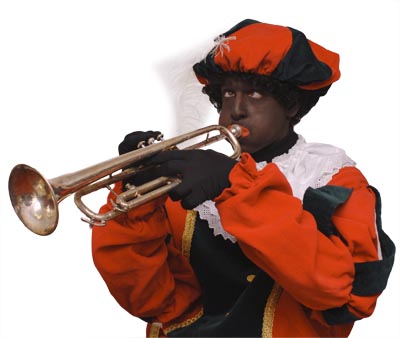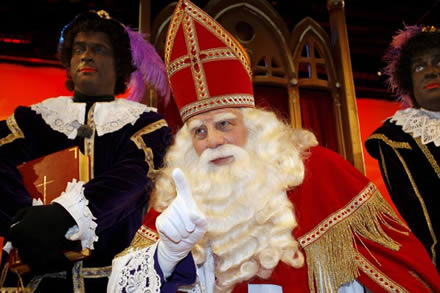
Zwarte Piet
Spiegel Online International discusses "Holland's Politically Incorrect Christmas: Santa's Little (Slave) Helper," by Daryl Lindsey.
Few European Christmas traditions elicit as many diverse and divergent opinions as Black Pete of the Netherlands. Santa's former slave may have been whitewashed in recent years, but many still view him as a racist caricature from the country's colonial past.

Myths about Santa's sinister helpers are as widespread in Europe as Grimm's Fairy Tales. In parts of Germany, Knecht Ruprecht brings terror into the hearts of naughty children when the gift-giving season arrives. In Austria it's Krampus, the horned devil who torments adolescents with asocial tendencies. In France, Pere Foutard does the proverbial whipping. Kids in America are threatened with coal in their stockings if they act up, but in European folklore, they are beaten with switches or stuffed in sacks. Brutal stuff. But in no country is the tale of Santa's diabolical sidekick as bizarre as in the Netherlands, home to Zwarte Piet ("Black Pete").
The story of Black Pete is unique on the continent and it is also one of Europe's oddest and most titilating Christmas traditions -- one that tends to raise the eyebrows of foreign visitors and local immigrants. No small number of people see the yuletide character as a racist emblem of Holland's colonial past.
Before trawling that debate, though, let's take a brief look at the myth that has defined the country's Holiday Season for the better part of a century and a half.

Many say it was Holland's Sinterklaas who inspired America's modern-day Santa. But that's where the similiarities end. Unlike Santa, who lives at the North Pole, Sinterklaas resides in sunny Spain. The Saint Nicolas figure that both are based on was actually a real Greek bishop who hailed from the city of Mira in what is modern-day Turkey. The Dutch version, however, is much more faithful to the original. With his gold crosier, red bishop's dress and red mitre, he's far more ecclesiastical looking than his portly American counterpart. And whereas Santa Claus is famous for circumnavigating the globe with a sleigh and his reindeer, Sinterklaas arrives in the Netherlands each year by, get this, steamship.
Steamship? At the time of the invention of Holland's modern Christmas myth by a Dutch schoolteacher in 1852, explains playright Mark Walraven, who recently wrote and staged a play critical of Black Pete, steamships were simply awe-inspiring. They must have been something akin to the Concorde or Richard Branson's Virgin Galactic spaceships.

Perpetually in tow is Sinterklaas' slave, Black Pete. At least that's what he was called from his 19th century origins up until the 1950s, when a new focus on cultural sensitivity led to a slight watering down of a tradition that was slowly subjected to the rigors of political correctness. In the new tale told to children each year, that pesky black face paint on Zwarte Piet's face comes from soot collected as Santa's helper wriggles down chimneys to deposit branches in the shoes of badly behaving kids or to help deliver presents from Sinterklaas for the good ones. Some whitewashers of this racist little tale also like to say he's a chimney sweep. "It's just an excuse used by people because they don't like to be reminded of the dark nature of Black Pete," says Walraven.
The arrival of Sinterklaas and Zwarte Piet is an event covered live on national television and the festivities are celebrated across the country. For several weeks, dozens of Zwarte Pieten and Sinterklaases can be seen crisscrossing the lowlands country, culminating on Dec. 5 with the exchange of gifts. Throughout the celebrations, you can buy Black Pete cakes, plush toys, balloons, chocolates and any number of knickknacks.

'If You Don't Behave, Black Pete Will Get You'
In the old days, parents would warn their children: "If you don't behave, Black Pete will come and take you with him back to Spain." Today, though, Black Pete -- and there are often a handful of them accompanying Sinterklaas as he makes his way around Dutch towns -- hands out cookies.
The new incarnation of Black Pete may be a chimney sweep and "Sinterklaas' helper," but efforts to make him less offensive haven't been totally successful. The thousands who dress each year as Black Petes still resemble players in a 19th century American minstrel show or a British Golliwogg. And in recent years, that has angered many in the Netherlands' black immigrant community, which stems largely from former colonies like Surinam in South America, the Antilles in the Caribbean or Africa.

Forty-six-year-old playwrite Walraven, whose drama "In the Shadow of the Saint" about the debate over Black Pete recently played at Amsterdam's Krater Theater, says he used to be one of the many white men in Holland who would paint their faces black each year to the delight of children. "I stopped after I began working with black people," he says. "Many people are offended by this symbol. In songs written before World War II, he was often called Sinterklaas's slave, and the texts of many songs and lyrics about him, especially from the 19th century, make it very clear that he was a racist symbol. In the end, Black Pete always comes across as a little stupid, clumsy and one who talks strangely and doesn't speak proper Dutch."
But in a country where Sinterklaas and Black Pete is a favorite tradition, talk like that can quickly spark a wildfire of anger. Though an increasing number of groups are speaking out against Black Pete, most Dutch don't see anything racist in the character and instead fear that critics are waging an all-out war on Christmas itself. An anti-Black Pete protest planned in the city of Eindhoven in September was cancelled after its organizers received death threats.

"The majority here in Holland refuse to talk about Black Pete," says playwright Walraven. "They are afraid that the people who discuss it want to take away Sinterklaas as a phenomenon."
One of messages of his play, which received a warm reception in the immigrant-filled neighborhood where it premiered, is that you can still have Sinterklaas without Black Pete. "Many countries have abolished these kinds of things, but in Holland they still exist," Walraven explains. "Nevertheless, most Dutch don't consider themselves to be racist and feel they are being personally attacked when you criticize Black Pete."

What would Walraven do with Black Pete? "I'd just get rid of him," he says. "You must admit that his origin is racist and that many people feel offended and hurt by it. It would be better to find another solution."
In the Dutch-speaking Belgian region of Flanders, at least one city has already altered its tradition, switching roles to make Sinterklaas a black man and Pete his white helper.
Felix De Rooy, the director who helped stage Walraven's plan in Amsterdam, has another idea. He recently suggested to the Dutch daily NRC Handelsblad that Black Pete could be replaced by far less decisive figures of almost equal popularity in Holland and Belgium: The Smurfs. (source: Spiegel Online International)

Next time please get your facts straight, Sinterklaas and Zwarte Piet have nothing to do with Christmas. And also, the origins of zwarte piet lie with the Moors, not African slaves. This also has to do with the fact that Sinterklaas comes from spain (in the tradition) which was for a long time interwoven with moorish affairs and vice versa.
ReplyDeletejdhsfkjdsfh:
ReplyDeleteOkay. Let me get this oxymoron of the "factual myth" straight.
The Moors were or were not Africans?
If they were from "Africa" that would make them Africans.
The Moors were Christian? I don't think so. The Moors were Islamic, not Christians. If so, then why were they deported from Spain in 1492. Follow the timeline of Christopher Columbus and the deportation of the Moors along with the deportation of the Spanish Jews. You can clearly trace why the Spanish needed to find an alternative route to India for the spice trade, hence the name of Native Americans as "Indians" (regardless of their culture or geographic location).
Secondly, the Dutch West African Trading Company (VOC). Not only did the Dutch have so called "New World" colonies in North America (New Amsterdam which became New York, and New Holland which became New Jersey), the Caribbean Islands of St. Croix, St. Marteen, St. Thomas (now the US Virgin Islands, purchased to protect the Panama Canal), and Suriname in South America just north of Brazil.
They also sold the first African slaves to the Jamestown settlement in 1619.
Furthermore, between 1501-1866 The Netherlands transported 554,336 Africans from Africa to be slaves in perpetuity. I won't even touch on their enslavement of Africans in South Africa.
If as you say, Zwarte Piet lies with the Moors, then how do you explain the skin color and hair texture? Moors don't have "black" skin, nor do they have kinky woolly hair. The outfit is certainly that of a Medieval Moorish dress, but the complexion and hair texture tell a different ethnic origin story.
Moreover, if Sinterklass was a Catholic Bishop of Turkey, then why would black Moors become his helpers. This was during the times of the Spanish Inquisition and the European Protestant v. Catholic wars too. It doesn't make any sense.
Six to eight black men accompanying Sinterklass to bring gifts to white European Christian children on their "free will"...Are you serious!
Sinterklass is a mythical creature, like Santa Claus. Both are of Dutch origin. Christmas has a strange way of blending the sacred with the profane, the pious religious with pagan traditions.
I'm sure if you scratch the surface of most, if not all, Christmas traditions you'll find most of them don't have one single thing to do with Christmas. It has more to do with national narratives, culture and tradition not facts.
I thought the video was funny. I can't understand a thing they are saying, but me and my kids laugh at the spectacle.
Lighten up, it's Christmas!
--Ron Edwards
The zwarte piet were freed slaves and
ReplyDeleteWestern also call them knecht which means paid helper we have a blacksmith knecht a farmers knecht and so on there is nothing discriminating
There are so many people who want te sauna stupide things about it when they know nothing I think USA has bigger problems with the discriminating president they elected
So minderdaad your opnieuw business